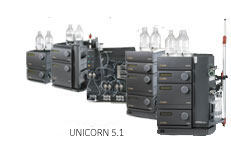

|
|

|
|
Base instruction
|

|
|
Bases

|
Every method block must
start with a Base instruction,
defining the base for calculating breakpoints.
Different
blocks can use different bases. The base can be one of the following:
-
volume (the unit depends on the
scale defined in the system strategy)
-
time (minutes)
-
column volume,
CV (defined as a numerical value or taken from the column definition)
-
SameAsMain (all
blocks apart from the main block), which means that the block will
inherit the base defined in the main block.
Method blocks that use a volume or column volume
base
Make sure that the flow rate is not zero. Volume breakpoints
are calculated from the flow rate of the pump, and the method will
not progress if the flow rate is zero.
|
|
|
|
|
What base should I use?

|
Use the base that most closely suits the purpose of the block.
Column volume is recommended as the base for most steps in a run.
In some situations, however, it may be more suitable to use a time
or volume base for individual blocks.
To change the base for an existing method
Be careful when changing the base for an existing method.
Changing between time and volume bases can affect the relative duration
of steps in the method if different steps use different flow rates.
|
|
|
|
|
Column parameter: named column

|
If a named column is selected for the Column parameter
in the Other:Base instruction,
the volume specified in the selected column definition will automatically
be used for column volume in the method block. The column volume for
base CV cannot then be changed
in the instruction or defined as a variable. However, the Column parameter should be defined
as a variable. Choosing a column definition also enables linear
flow rate and column performance calculations.
|
|
|
|
|
Column parameter: Any

|
If the Column parameter
in the Other:Base instruction is set to Any and the Base parameter is set to CV, the column volume is set numerically
by the Volume parameter.
The column volume may be defined as a variable, allowing the scale
of the run to be decided when the method is actually run.
|
|
|
|
|
How to select columns for a template or
wizard

|
In cases where a template or wizard-generated method and
column are chosen, it is easy to select other columns for that method
on the Variables tab in Run Setup.
Note: This might
not be possible for methods that you have created yourself.
|
|
|
|
|
How to select columns for a method not selected from a template

|
The
table below describes how to select columns for a method, not selected
from a template.
|
Step
|
Action
|
|
1
|
In the Instruction box of
the Text instruction dialog
box, mark the Other:Base instruction.
|
|
2
|
-
Select the
required column from the drop-down list for the Column parameter.
-
Click the Var... button
to define the Column parameter
as a variable. This is an optional but recommended step that will
make it easy to change the column selection for different runs.
|
|
3
|
|
|
|
|
|
|
Column definition

|
A column definition can be chosen and defined as a variable
even if the base for the block is set to volume or time. Parameters
in the column definition will then be used for linear flow rate
and column performance calculations.
Recommendation
A selected column definition applies locally within the block
for which it is selected, and is not transferred to other blocks.
We strongly recommend that the column definition be selected for
the main block.
|
|
|
|
|
Update parameters

|
If you want parameters (for example, flow, pressure and averaging
time) to be updated when you change the column, you must define
these as variables.
|
|
|
|
|
Pump:Methodbase instruction

|
Volume or column volume base is calculated from the flow rate
of the SystemPump or the SamplePump, selected with the
instruction Pump:Methodbase.
If no Pump:Methodbase instruction
is included in the method, the default setting SystemPump will be used.
|
|
|
|
2005-06-15
|
|
|
